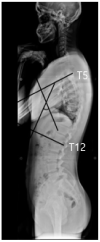Effects of Combined Exercise Program on Spinal Curvature and Balance Ability in Adolescents with Kyphosis
- PMID: 36553442
- PMCID: PMC9776914
- DOI: 10.3390/children9121999
Effects of Combined Exercise Program on Spinal Curvature and Balance Ability in Adolescents with Kyphosis
Abstract
Thoracic hyperkyphosis is associated with postural abnormality, physical function, and quality of life. This study aimed to examine the effects of a combined exercise program on the spinal curvature and balance ability in adolescents with kyphosis. Fifty-one adolescents (mean age 21.95 ± 3.90 year, 23 male and 28 female) diagnosed with kyphosis were randomly divided into two groups: an experimental group (n = 25) and a control group (n = 26). All participants in the study group underwent a combined exercise program for 60 min, three times per week, for 12 weeks. Cobb’s angle and forward head angle showed significant differences between the two groups (p < 0.001). The anterior and posterior weight distributions of static and dynamic plantar foot pressures showed a significant difference between the two groups (p < 0.001), and significant differences were observed only in the study group (p < 0.001). However, the left and right static plantar foot pressures did not differ significantly. In conclusion, these results demonstrate that a combined exercise program is an effective intervention for the improvement of alignment in the spinal curve and balance in adolescents with postural kyphosis.
Keywords: Cobb’s angle; balance; complex exercise; postural kyphosis; spinal curvature.
Conflict of interest statement
No potential conflict of interest relevant to this article was reported.
Figures
Similar articles
-
The Effectiveness of Exercise Programs in Adolescents with Thoracic Kyphosis: A Narrative Review.Healthcare (Basel). 2024 Jul 29;12(15):1503. doi: 10.3390/healthcare12151503. Healthcare (Basel). 2024. PMID: 39120206 Free PMC article. Review.
-
Effects of Corrective Exercise for Thoracic Hyperkyphosis on Posture, Balance, and Well-Being in Older Women: A Double-Blind, Group-Matched Design.J Geriatr Phys Ther. 2019 Jul/Sep;42(3):E17-E27. doi: 10.1519/JPT.0000000000000146. J Geriatr Phys Ther. 2019. PMID: 28914720 Clinical Trial.
-
The Effect of a Comprehensive Corrective Exercise Program on Kyphosis Angle and Balance in Kyphotic Adolescents.Healthcare (Basel). 2022 Dec 8;10(12):2478. doi: 10.3390/healthcare10122478. Healthcare (Basel). 2022. PMID: 36554002 Free PMC article.
-
An investigation into the effects of kinesiotaping for posture correction on kyphosis angle, pain, and balance in patients with postmenopausal osteoporosis-associated thoracic kyphosis.Arch Osteoporos. 2019 Aug 13;14(1):89. doi: 10.1007/s11657-019-0634-x. Arch Osteoporos. 2019. PMID: 31410649 Clinical Trial.
-
Effect of Therapeutic Exercise on the Management of Hyperkyphosis in Adolescence and Young Adulthood: A Systematic Review.Physiother Res Int. 2025 Jul;30(3):e70078. doi: 10.1002/pri.70078. Physiother Res Int. 2025. PMID: 40474601 Free PMC article. Review.
Cited by
-
The Influence of Body Composition on Sagittal Plane Posture among Elementary School-Aged Children.Children (Basel). 2023 Dec 28;11(1):36. doi: 10.3390/children11010036. Children (Basel). 2023. PMID: 38255350 Free PMC article.
-
The Effectiveness of Exercise Programs in Adolescents with Thoracic Kyphosis: A Narrative Review.Healthcare (Basel). 2024 Jul 29;12(15):1503. doi: 10.3390/healthcare12151503. Healthcare (Basel). 2024. PMID: 39120206 Free PMC article. Review.
-
The impact of additional visual tasks in physical exercise on balance ability among 9-10-year-old children: the mediating effect of visual acuity.Front Public Health. 2024 Jan 8;11:1270947. doi: 10.3389/fpubh.2023.1270947. eCollection 2023. Front Public Health. 2024. PMID: 38259731 Free PMC article.
References
-
- Seok S.I. Textbook of Spinal Surgery (Spinal Surgery) Newest Medical Publishing Company; Seoul, Republic of Korea: 2011.
-
- Choi S.W. A Comparative Study on Body Composition and Spine Curvature of Women in Their 20s according to Exercising Habits. Korean J. Sport Sci. 2022;31:837–844. doi: 10.35159/kjss.2022.8.31.4.837. - DOI
LinkOut - more resources
Full Text Sources
Molecular Biology Databases



